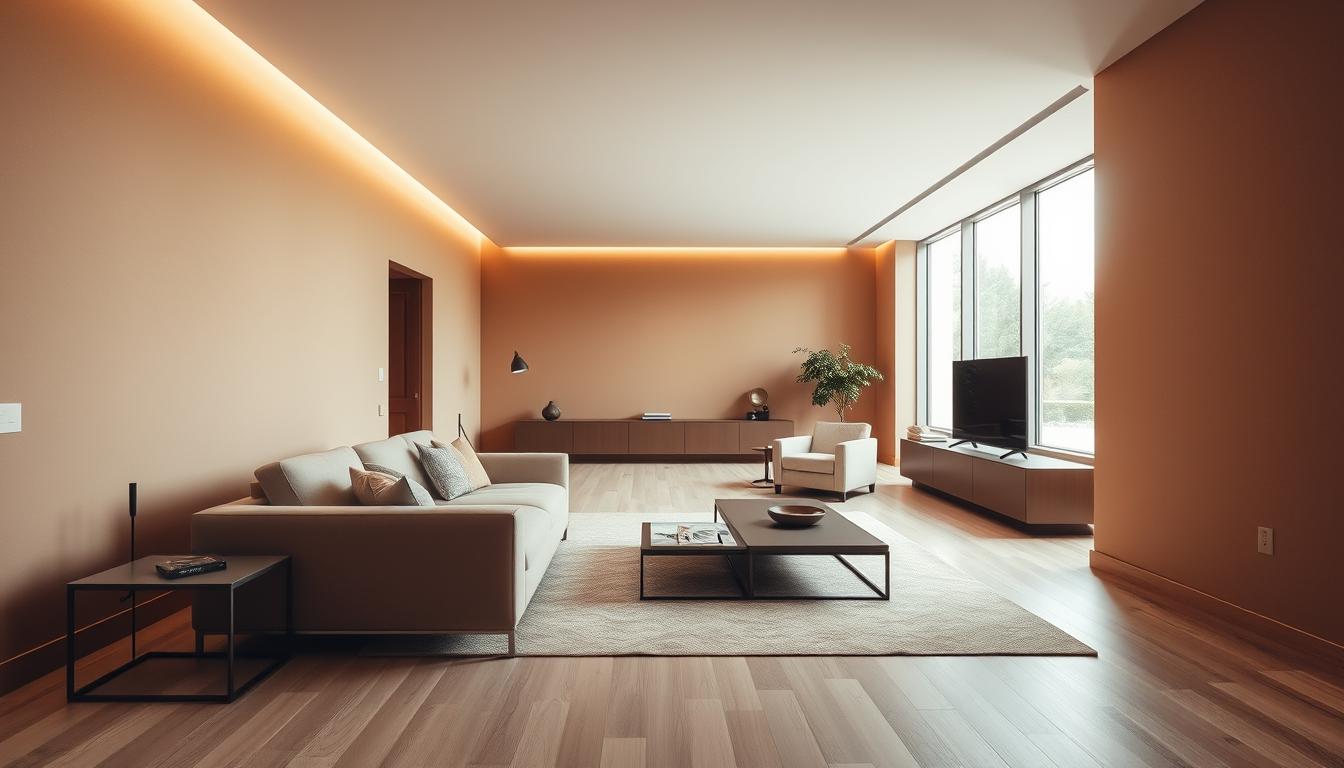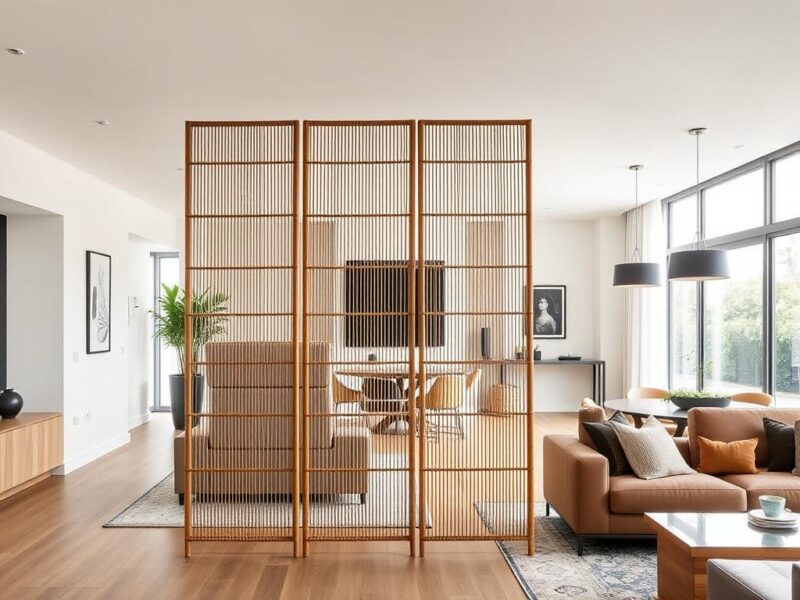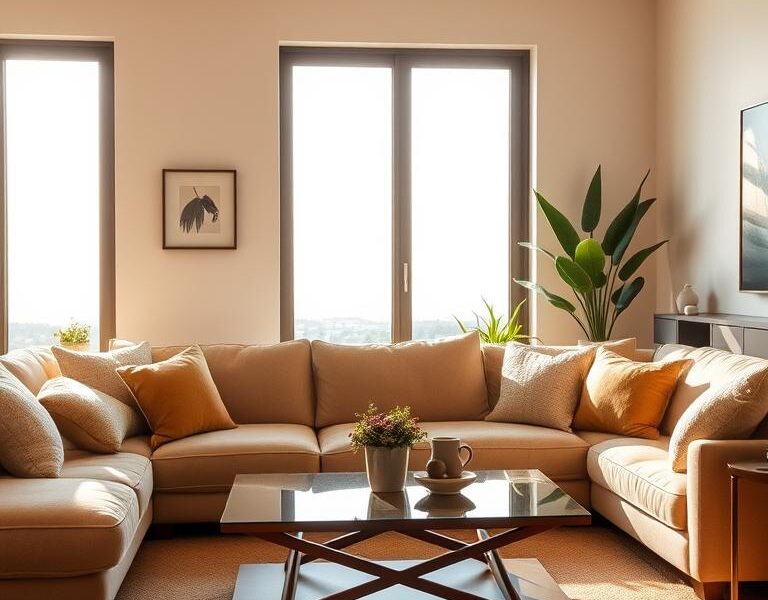Did you know that over 40% of homeowners struggle with awkwardly shaped spaces? If your home has a slim, rectangular area, you’re not alone. Many face the challenge of making it both stylish and functional.
Take Sarah, for example. She transformed her 23’x11′ space into a cozy yet spacious retreat. By using smart design tricks, she avoided the dreaded “corridor effect” and created zones for relaxing, working, and entertaining.
The key? Floating furniture, vertical storage, and multi-functional pieces. These solutions help maximize every inch while keeping the flow natural. Ready to turn your tricky space into a highlight of your home?
Key Takeaways
- Many homeowners struggle with slim, rectangular spaces.
- Smart layouts prevent the “corridor effect.”
- Floating furniture improves flow and functionality.
- Vertical storage saves floor space.
- Multi-functional zones work for families and guests.
Understanding Your Long Narrow Living Room Layout
Every home has its quirks, and slim rectangular areas demand special attention. Before moving any furniture, take time to study your space’s natural flow and architectural features. This step saves hours of rearranging later.

Assessing Obstacles and Flow
Start by mapping traffic patterns. Note doorways, hallway connections, and permanent fixtures like fireplaces or large windows. These elements dictate how people move through the area.
Try this pro tip: Use graph paper to sketch your dimensions. Mark all entry points and permanent features. Sarah discovered her 23’x11′ space had three busy pathways that needed clear access.
Identifying Focal Points
Every great design needs an anchor. Natural focal points like fireplaces or picture windows grab attention. But what if your space lacks one?
Create visual interest with:
- A bold media wall with your TV and shelving
- Oversized artwork on the largest blank wall
- An accent wall with textured wallpaper
Remember: Your focal point should face seating areas. This creates natural conversation zones and prevents that tunnel-like feeling.
Key Considerations Before Rearranging Furniture
Smart furniture arrangement starts with understanding your household’s unique needs. Whether it’s movie nights with the family or a quiet workspace, your layout should adapt to daily life.

Seating Needs and Room Purpose
Audit how you use the space. Do the kids need homework areas? Is hosting a priority? List activities like:
- Weekend movie marathons
- Art projects or playtime
- Remote work or studying
Calculate seating using the 18″ rule—each person needs about 1.5 feet of couch or chair space. An 8’ sofa fits 5–6 people comfortably.
How to Define Zones Effectively
Break the area into zones based on function. A 10’x10’ spot works for conversation areas, while an 8’x10’ rug anchors a TV zone.
Try multi-purpose tricks:
- Ottomans with hidden storage for blankets
- Nesting tables that expand for game nights
- Bookshelves as room dividers
Keep pathways clear—your family should move easily between zones without tripping over furniture.
Breaking Free from the “Corridor Effect”
That hallway feeling in your space? It’s fixable with smart design moves. The corridor effect happens when furniture hugs long walls, creating a tunnel-like vibe. Instead, pull pieces inward for balance.

Try the 45-degree angle trick. Place sofas or chairs diagonally to disrupt straight lines. This simple shift makes the layout feel dynamic and spacious. Sarah used this with her console table, creating a 38% wider visual perception.
Mark pathways naturally:
- Planters or floor lamps guide traffic without blocking views
- Low-profile rugs define zones while keeping flow open
- Mirrors reflect light to “push” walls outward
Optical illusions work wonders. Horizontal stripes on rugs widen the space, while vertical art draws eyes upward. For more ideas, explore these layout hacks.
Floating Furniture: A Game-Changer for Narrow Spaces
Ever feel like your furniture is stuck to the walls? Freeing pieces from perimeter placement creates breathing room. This technique tricks the eye into seeing more space while improving traffic flow.

Why You Should Pull Furniture Off the Walls
Wall-hugging arrangements make rooms feel like bowling alleys. By floating your sofa 18-24 inches from walls, you create valuable walkways behind it. This also allows for functional additions like slim tables.
The extra depth makes seating feel cozier too. Guests won’t shout across a void, and lamps can illuminate from behind. Just ensure heavy pieces have proper weight distribution.
Choosing the Right Pieces to Float
Not all furniture floats equally well. Look for apartment-sized sofas under 72 inches long—they’re easier to center. Pair them with a console table (12-14 inches deep) for books and decor.
Sectionals work if you keep one side against a wall. For media units, choose low-profile designs with built-in cord management. A console table behind seating adds surface area without crowding.
Remember: Floating works best when you maintain clear pathways. Use rugs to anchor each zone while keeping walkways open.
Creating Functional Zones in One Long Space
Transform your challenging space into a well-organized haven with smart zoning. By dividing the area into purposeful sections, you’ll enhance both style and usability. Think of it as creating mini-rooms within one stretch.

Conversation Areas vs. Activity Zones
A conversation zone thrives with facing sofas or chairs spaced 3–4 feet apart. For kids or hobbies, dedicate a corner with durable mats and storage bins. Pro tip: Use bookshelves as subtle dividers.
“Always leave 36 inches between zones—enough space to walk comfortably without disrupting activities.”
Using Rugs to Define Each Zone
Rugs anchor each section visually. Size them 24 inches wider than furniture groupings—like an 8×10 for a sofa-and-coffee-table combo. For a reading nook, try a round rug to soften angles.
- Sound control: Thick rugs with pads reduce noise in play zones.
- Color coding: Cool tones (blues/greens) for relaxation; warm hues (oranges/reds) for lively spots.
- Safety first: Non-skid pads (0.25” thick) prevent slips.
For inspiration, see how this rug-defined TV zone balances style and function. Layers make the magic happen!
Smart Furniture Choices for Long Narrow Living Rooms
The secret to a functional layout? Strategic furniture picks. The right pieces maximize flow while adding style. Focus on shapes and sizes that enhance your space without crowding it.

Opting for Round Coffee Tables
Square tables eat up walkways, but a round coffee table saves the day. Its curved edges soften angles and improve traffic flow. Stick to a 36–42″ diameter for balance.
Follow the 16″ clearance rule: Leave enough room to walk around comfortably. Glass tops add visual lightness, while ottoman hybrids offer hidden storage.
- Safety first: Rounded edges prevent bumps in tight spots.
- Multi-tasking: Use trays to turn ottomans into surfaces.
- Pro tip: Match the table’s finish to your flooring for cohesion.
The Power of Console Tables
Slim and versatile, a console table anchors floating sofas. Choose one within 6″ of your sofa’s width—this keeps proportions in check. Dual-level designs add vertical storage without bulk.
Style it with:
- Stacked books and a small lamp for ambiance
- Baskets or bins to hide clutter
- A mirror above to reflect light
“A console behind your sofa adds function without sacrificing space.”
Vertical Design Tricks to Expand Your Space
Height is your best friend when working with limited floor space. By directing attention upward, you create the illusion of airiness without changing your square footage. Walls and ceilings become valuable real estate for both function and style.

Tall Storage Solutions
Built-in cabinets reaching near the ceiling maximize every inch. For 8-foot ceilings, install shelves at 84″ to leave breathing room. This keeps items accessible while maintaining clean lines.
Try these space-saving ideas:
- Picture rail systems – Swap artwork without wall damage
- Vertical gardens – Use wall-mounted planters for greenery
- Floor-to-ceiling curtains – Hang rods 4-6″ above windows
Artwork and Lighting to Draw the Eye Up
Strategic placement guides vision vertically. Large artwork above seating areas creates instant focal points. For galleries, arrange pieces in columns rather than rows.
Lighting plays a crucial role too:
- Pendant lights at varying heights add dimension
- Uplights with a 3:1 wall wash ratio brighten dark corners
- Mirrors reflect both natural and artificial light
“Vertical elements make small spaces feel intentional rather than cramped.”
Remember to balance function and aesthetics. Every upward element should serve a purpose while pleasing the eye. Your space will feel taller, brighter, and infinitely more polished.
Real-Life Long Narrow Living Room Layout Ideas
Good design transforms tricky dimensions into functional beauty—here’s how. These proven arrangements maximize your length room without sacrificing comfort. See what worked (and what didn’t) for homes like yours.
L-Shaped Sectionals for Cozy Corners
An sofa with an L-shape tucks perfectly into corners. Keep it under 126″ for 12-foot long walls—any larger overwhelms the space. Leave 42″ clearance for walkways.

- Creates intimate conversation nooks
- Works for family movie nights or solo reading
- Swivel chairs add flexible seating
Centered Layouts for Balanced Flow
Sarah’s 18’x9’ space succeeded by floating furniture. Her 84″ sofa faces two accent chairs with a 36″ round table between them. This creates dual focal points—a fireplace and TV wall.
Key measurements:
- 48″ between seating groups
- 18″ behind floating pieces
- 24″ wide pathways
“Centering furniture creates natural circulation paths on both sides.”
Conclusion
Your home deserves a layout that works as hard as you do. Remember the golden rule: Keep 16″ clearance around coffee tables for smooth traffic flow. Small tweaks make big impacts.
Don’t fear experimentation. Try floating your sofa for a week or test a new rug size. Quarterly furniture audits help adapt to changing needs. Vertical storage? Always a win.
Like Sarah, you can blend style and function. Her once-awkward space now wows guests. Yours will too—one smart adjustment at a time.


